Australian
and international
exploratory
performance and
media arts
Courtesy of Hopscotch Films we have 3 double passes to give away:*
we need to talk about kevin
directed by Lynne Ramsay
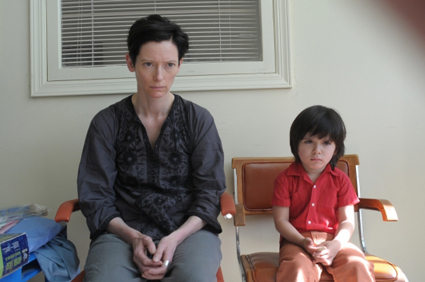
Tilda Swinton, Jasper Newell, We Need to Talk About Kevin
Based on Lionel Shriver’s book, We Need To Talk about Kevin is a chilling and captivating exploration of parenthood, guilt and nature vs nurture. Tilda Swinton plays Eva, the mother of the sociopathic teenager Kevin, reliving his upbringing in an attempt to ascertain the reasons for his devastating actions. We Need To Talk About Kevin was awarded best film at the 2011 London Film Festival.
To be in the running for one of the double passes please send an email with the movie title as the subject to onlinegiveaways@realtimearts.net.
Please include name, address and contact number
Please apply before 2pm Nov 23
See www.hopscotchfilms.com.au/ for more Hopscotch releases
*Unfortunately the movies are not currently playing in the Northern Territory
RealTime issue #105 Oct-Nov 2011 pg. web
© RealTime ; for permission to reproduce apply to realtime@realtimearts.net
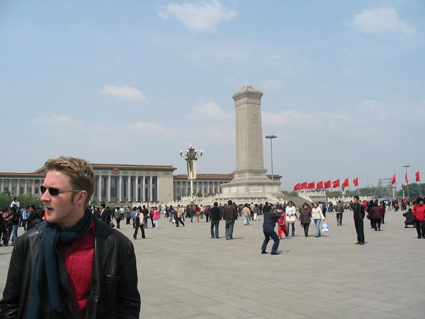
Dan Edwards
Bio
I grew up in the Blue Mountains, but ran away to Sydney as soon as possible. With a view to becoming a rock star I ran away to London, but quickly realised it was full of rain and misery, so I came back. After 15 years and a stint in the public service I ran away to China for four years. Now living in Melbourne and regularly eyeing travel agent specials.
China opened my eyes, broadened my mind, blackened my lungs, taught me the true meaning of friendship and at times made me sadder than I’ve ever been. I’ve always been fascinated by difference and intrigued by anyone, anything or anywhere that’s unlike me. The People’s Republic satisfies amply on all counts, which probably explains why I’m still in an obsessive love-hate relationship with the place.
Exposé
I’ve tried everything from dishwashing to couriering to bureaucratic middle management, but the one thing that I’ve always done is writing. My poetry is awful and my short stories mediocre, but I seem to have a knack for journalism—particularly film journalism and criticism. It’s also easier to get paid if you call yourself a journalist rather than an artist, a tip I got from Henri Cartier-Bresson.
Writing about film is a way to combine my love of words and images. Criticism for me is about shining a light on a work, illuminating its complexities and helping others see something they might not have considered. I’ve done my job if the reader comes away knowing something new, or looking at the world from a different angle. For a true wordsmith, you are what you write, so always be true to yourself and your subject.
Although I’ve written for many publications, including The Age, Meanjin, The New Matilda and The Diplomat, RealTime has published more of my work than any other magazine, and I’ve consistently enjoyed writing for RealTime more than any other title. Unlike much mainstream press, RealTime is always open to new works, new ideas and new voices. In a life spent wandering, writing for RealTime is like coming home. The other publications are just pleasant sojourns.
Recent articles for RealTime
RT105 Ghostly Tales from Our Northern Neighbours—the Fourth Portrait & Eternity, Melbourne Film Festival
RT105 A Nation Slips Under the Waves—Tom Zubrycki’s The Hungry Tide
RT104 Beyond the TV Frame—Antenna International Documentary Festival
RT103 You Can’t Build on an Emptiness—IFChina Original Studio
Other writing
See my website (www.danedwards.net) for a full list of my publications, or my blog on Chinese film, Screening China: http://screeningchina.blogspot.com
RealTime issue #105 Oct-Nov 2011 pg. web
© Dan Edwards; for permission to reproduce apply to realtime@realtimearts.net
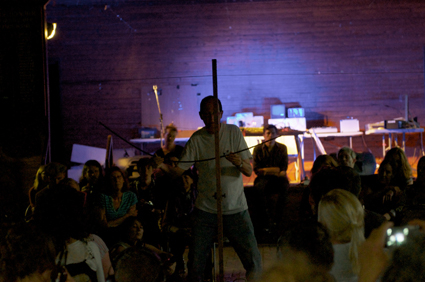
Alan Lamb, WIRED Open Day 2011
photo Mattias M. Morelos
Alan Lamb, WIRED Open Day 2011
SINCE ITS INCEPTION IN 2007, THE WIRED LAB HAS QUICKLY ESTABLISHED A REPUTATION AS ONE OF THE MOST INTERESTING SITES OF ACTIVITY IN AUSTRALIAN SOUND ART, THROUGH ITS ONGOING COMMITMENT TO RESEARCH THAT BRINGS TOGETHER ART AND SCIENCE IN THE RURAL SETTING OF MUTTAMA IN SOUTH WEST NSW.
The eponymous Wires are large-scale Aeolian instruments developed by West Australian artist/scientist/physician Alan Lamb, who has been exploring their potential since the 1970s, initially with found telegraph wires. At the WIRED Lab, a purpose-built collection of The Wires exists as a permanent installation on a large area of farmland. The residents of this land, artist/curator Sarah Last and artist/scientist David Burraston have been working closely with Lamb on the documentation and further development of his work, as well as opening up The Wires to exploration and collaboration with local and international artists and researchers, through regular workshops and residencies.
WIRED Open day is a biennial event that showcases both The Wires and work made with them. This year, due to inclement weather, the event was forced to relocate from the farm to nearby Muttama Hall. While it was disappointing that the audience didn’t get to experience The Wires, the community hall (established in 1925 and looking like it hadn’t changed much since) turned out to be a very suitable location for an event that was in many ways a celebration of community.
Some in the audience had in fact already experienced The Wires, including a large gathering of emerging sound artists from around Australia who had converged on the WIRED Lab for a residency over the previous week. The weather had thwarted their plans to develop a work for this event, but the performances they experienced would turn out to be a fitting masterclass.
The local community also showed great interest and the hall was soon full of a diverse range of people, including children, as well as many long-distance travelers like myself, who were bused in from the nearby town of Cootamundra. Prior to the performances we were treated to the country hospitality of a big spread provided as a fundraiser for the Cootamundra Creative Arts and Cultural Centre . While we ate and drank beer, we wandered outside the hall, where two tents containing sound installations had been set up.
The first tent contained a work by Chris Watson, the renowned UK field recordist and former member of Cabaret Voltaire. His installation was a time compression of the environmental sounds around the WIRED lab, which he had recorded over a period of 24 hours during a residency in 2009. Wet, windy atmospheres and a range of birdcalls were eventually joined by the singing of The Wires steadily increasing in intensity. More than just a beautiful soundscape, with Watson’s trademark crystal clear fidelity, this is also an excellent example of acoustic ecology, documenting the sounds of an endangered habitat. Watson was to have attended the Open Day, but was instead called to Burma to record the sound for what may be one of David Attenborough’s last documentaries.
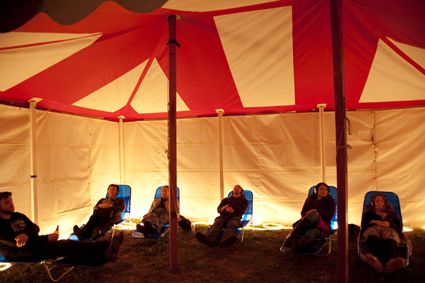
Garry Bradbury and David Burraston, Dormative Fields, WIRED Open Day 2011
photo Sofie Muceniekas
Garry Bradbury and David Burraston, Dormative Fields, WIRED Open Day 2011
At the other tent I was met with the striking scene of people lying on deckchairs listening on headphones. This was Garry Bradbury and David Burraston’s Dormative Fields, a work made for relaxing or even sleeping to. Each chair came with a different piece of music with The Wires as source material. These works were notable for their subtle and sophisticated use of repetition and dub-like studio mixing techniques, while remaining sensitive to the organic nature of the sounds. One chair was not like the others, instead it contained a lively and amusing discussion about tartans—a lovely surprise and presumably a playful reference to Lamb’s Scottish heritage.
Back inside the hall proceedings began with a warm welcome to country from Peter Beath, who gave us illuminating insights into his family’s relationship with the area. Event organiser Sarah Last then introduced the program and Lamb’s work by playing “Last Anzac” a piece from Lamb’s 1998 CD Night Passages in order to “get our ears in.” This was classic Wire music. Throbbing bass filled the hall, eventually giving way to a constantly shifting palette of metallic drones and static tones, like frozen sirens. While superficially sounding like dark ambient or industrial music, it is really just a (framed and edited) document of the sound world of The Wires.
Unlike most stringed instruments, The Wires are so long that they vibrate at a fundamental frequency well below human hearing, and therefore have closely spaced harmonics that are multiples of that very low frequency. What we hear then is the often chaotic interplay of its higher harmonics, activated and modulated by environmental phenomena and/or by human intervention. The resulting timbres and harmonies are endlessly fascinating and compelling, and remarkably dramatic—Lamb’s recordings are featured on a number of film soundtracks. “Last Anzac” is a recording of Wire music at its finest.
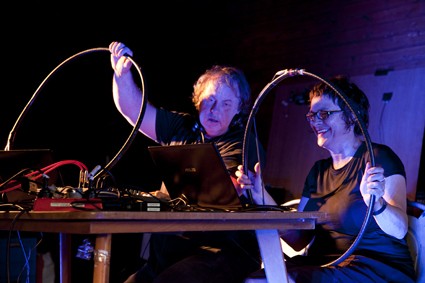
David Haines & Joyce Hinterding, WIRED Open Day 2011
photo Sofie Muceniekas
David Haines & Joyce Hinterding, WIRED Open Day 2011
Next up was a work by David Haines and Joyce Hinterding. Well-known for their collaborative media art practice and their individual sound art practices, this was a rare duo sound performance. They each had a large hoop antenna (made from bicycle wheels) which captured the electromagnetic fields around their laptops. This source material was then fed back into the computers for processing and layering with other sounds. Whistling harmonics similar to throat singing anchored the piece as the artists waved their antennae around their equipment to find hisses, hums and crackles. Haines was particularly animated, moving around the stage to explore the other artists’ equipment, at one point even putting his antenna around Hinterding’s neck! The visual impression was of surreal rhythmic gymnastics in slow motion, but the sound was hypnotic. It wasn’t Wire music—having spent time with The Wires, the artists had found them, ironically, too electromagnetically sensitive for their purposes—but the performance had the same profound effect of opening doors to previously unheard realms.
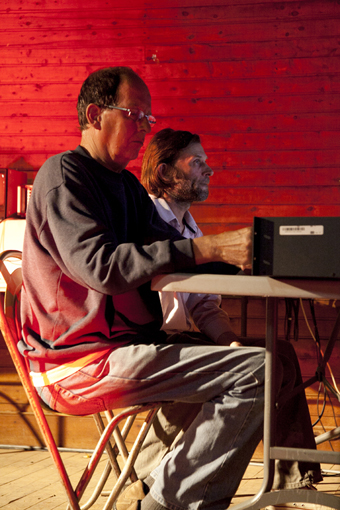
Alan Lamb, David Burraston, WIRED Open Day 2011
photo Sofie Muceniekas
Alan Lamb, David Burraston, WIRED Open Day 2011
Above our heads, across the middle of the hall stretched a wire, anchored to the floor at its centre by a vertical wire. We moved our seats to form a circle as Lamb prepared for the next performance by tuning his instrument. He then began to play it with his Great Bow, which looks more like an archery bow than part of any stringed instrument. With it he teased out harmonics that resonated throughout the space. What might have been a literally monotonous performance was given great visual interest by Lamb’s lanky frame swaying like a tree in the wind as he played, while the sun set and the hall turned dark. Lamb’s intimate relationship with the instrument was clear as he communed with it in an almost ritualistic dance.
After an intermission Last introduced her “partner in life and art” David Burraston (aka Dave Noyze) and his array of equipment, which included two variations of another of Lamb’s inventions, a feedback generator called the Infinite Music Machine. Alongside these were a cellular automata sequencer (the subject of Burraston’s doctoral research) and sundry other electronic devices. Beginning with the air of a mad scientist giving a demonstration of his findings with little regard for aesthetics, the performance became more musically satisfying as it progressed and deeper, more complementary tones merged with the beautiful sound of rain falling on The Wires.
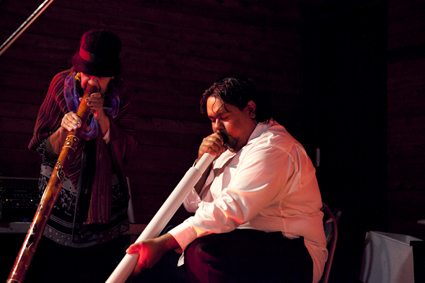
Delmae & William Barton, WIRED Open Day 2011
photo Sofie Muceniekas
Delmae & William Barton, WIRED Open Day 2011
For the final performance of the night, Burraston was joined by Lamb, as well as William and Delmae Barton who had been recent WIRED Lab residents. William is a master didgeridoo player and his mother Delmae an esteemed singer. As Last introduced them we learned that although Delmae had serendipitously developed her own style with the didgeridoo (generally an instrument played by men), she later learned from elders it was similar to the way some women had traditionally played it in the past.
The piece began with Lamb and Burraston at one end of the stage, mixing cavernous recordings of The Wires, sounding like a symphony stretched out beyond recognition. This lasted for several minutes before William Barton punctuated it with a series of assured yet delicate interventions from his slide didgeridoo. The reverberant swell of The Wires re-emerged, joined by birdcalls and eventually transforming into gongs and cymbals. As these receded and the didgeridoo came into its own there was an overlapping period that sounded almost Tibetan. But then Delmae began singing into her didgeridoo, a high, keening cry that was unlike anything I’d heard before. It only lasted for a minute, but by the end of it we were all in tears, knowing that we had just experienced something very special. Delmae dedicated her performance to the people of Muttama and to “all people of the world.” As we walked outside under the bright stars we felt simultaneously awed and yet closer together.
The Wires can be understood as an instrument to help us tune in to the environment, to sound, and to each other. Alan Lamb deserves credit for his important work, but it is Sarah Last’s curatorial vision that is particularly deserving of praise for its powerful combination of inclusiveness and rigour. She tells me that “as much as I am curating/creating potentialities for the development of discrete projects, I am also attempting to create an experience of landscape and community. I want the experience of these projects to be powerfully subtle, seemingly organic and much like the way culture naturally evolves.” The work of Sarah Last and the WIRED Lab offers experiences through which we may better appreciate and engage with the most important questions of existence.
WIRED Open Day, October 29 2011, Muttama NSW, http://wiredlab.org
Shannon O’Neill is an artist, academic and curator. He runs the website Alias Frequencies http://aliasfrequencies.org and is also assisting the WIRED Lab with it’s website.
RealTime issue #105 Oct-Nov 2011 pg. web
© Shannon O’Neill; for permission to reproduce apply to realtime@realtimearts.net
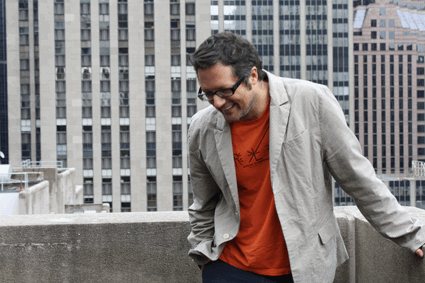
portrait Rafael Lozano-Hemmer, photo Ana Cristina Enrique; installation shot People on People, Rafael Lozano Hemmer 2010, Recorders Manchester Galllery UK, photo Peter Mallet
“antimonuments for alien agency”
This is what Mexican-born, Canadian-based artist Rafael Lozano-Hemmer calls his interactive installations. Hemmer has visited Australia several times over the last few years, appearing at the 2009 Adelaide Film Festival as keynote speaker (see RT89) and also as the guest artist of Federation Square’s 2010 Light in Winter Festival presenting his major work Solar Equation (see the interview in RT97 and review of the work in RT99). He returns to Australia in December to present the MCA’s Lloyd Rees Memorial lecture: Antimonuments and Subsculptures, just prior to the opening of his major exhibition, Rafael Lozano-Hemmer: Recorders, in one of the new galleries of the MCA. In this lecture he will discuss some of his more recent projects: Voz Alta, a memorial for the Tlatelolco student Massacre in Mexico City in 1968; Levels of Nothingness, a performance for the Guggenheim Museum NYC; and Vectorial Elevation, for Vancouver Winter Olympics. “Inspired by phantasmagoria, carnival and animatronics” (press release), the exhibition will feature 12 works including two made especially for Sydney, all of which encourage high levels of audience interaction to create their magic. 2011 Lloyd Rees Memorial lecture: Antimonuments and Subsculptures, Dec 5, 6.30-8pm, The Studio, Sydney Opera House, bookings www.sydneyoperahouse.com; Rafael Lozano-Hemmer: Recorders, Dec 16-Feb 12, Museum of Contemporary Art; http://www.mca.com.au/
up close and personal
In a celebration of the confessional comes The Horse’s Mouth, a festival of autobiographical performance. Over three programs, some of Sydney’s more intriguing performance and theatre makers will be baring their souls and sharing their sordid histories. Program A: Bolted, features Zoe Coombs Marr sharing stories of a failed road trip (see reviews of Coombs Marr’s recent solo And That Was The Summer That Changed My Life; POST’s Who’s the Best and Everything I Know About the Global Financial Crisis in One Hour); Tim Spencer in conversation with a male sex worker; and Phil Spencer (director of the event) exploring his relationship with his Nana, rock ‘n’ roll wrestling and cake. Program B: In Hell for Leather Jono Burns explores a sense of home through his escapades in New York, while Zoe Norton Lodge reveals the idiosyncrasies of her family through a study of household neglect and a love of possums. The final program, One Trick Pony is an evening of short works by Nick Coyle, Scarlet McGlynn, Betty Grumble and Alex Vaughan. And on Sunday’s there’s also a Story Club where perhaps everyone can share! Bambina Borracha Productions in association with Tamarama Rock Surfers Theatre Company: The Horse’s Mouth, artistic director Phil Spencer? producer Vanessa Hughes, Nov 24-Dec 17, Tues-Sun 8pm, The Old Fitzroy Theatre, www.horsething.com
collectors items
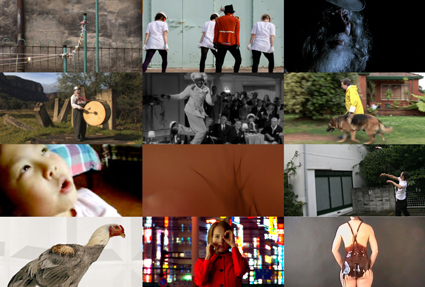
DELUXE dLux Edition#1
dLux media arts has just launched DELUXE: dLux Edition #1 designed as an introduction to video art for collectors and featuring works by Dani Marti, Daniel Mudie Cuningham, Angelica Mesiti, John A Douglas, SODA_JERK, Kate Murphy, Elvis Richardson, John Tonkin, Denis Beaubois, Hayden Fowler, Sue Healey and Julie Rrap. There will only be 100 produced, each “in a funky aluminium travel case,” and it’s priced at $295 with the proceeds going to make up the funding short-fall that dLux has just suffered. Undeterred, dLux is also currently presenting The Garden of Forking Paths, an exhibition of game art curated by Neil Jenkins at the Tin Sheds Gallery. Featuring games designed by artists spanning 30 years such as Puppet Motel by Laurie Anderson (USA) with Hsin-Chien Huang (Taiwan) 1995; Frame Game by Michael Nyman (UK) 2003 and CuteXDoomII by Anita Fontaine (Aus) & Mike Pelletier (Canada) 2008, visitors can actually play the games, some of which need almost ancient seeming technology to run. The exhibition was first presented during the 2009 Electrofringe in Newcastle (reviewed here) and has already toured to Burnie and Port Macquarie, and will be presented at Bathurst Regional Gallery in 2012. DELUXE: dLux Editions #1, $295; The Garden of Forking Paths, curator Neil Jenkins, The Tin Sheds Gallery, Nov 4-26 ; http://www.dlux.org.au/
A new DVD publication, Short Play, is inaugurated with Volume 00:01 Play. Curated by Rachel Feery it features short works that explore the idea of play in film, performance, installation, new media and animation with works by Brown Council, Hit&Miss, Rachel Feery + Lisa Stewart, Timothy P Kerr, Jane Korman, Alanna Lorenzon, Riki-Metisse Marlow, Ms&Mr, Hannah Raisin, Safari Team, Sam Smith, Lachlan Tetlow-Stuart, Michael Vale and Jemima Wyman. The video works are also contextualised by six essays. With 500 produced the DVD costs $20 plus postage and can be bought online or found in a range of galleries. Short Play Publications, Volume 00:01 Play; http://shortplaypublications.com.au/
ears around melbourne
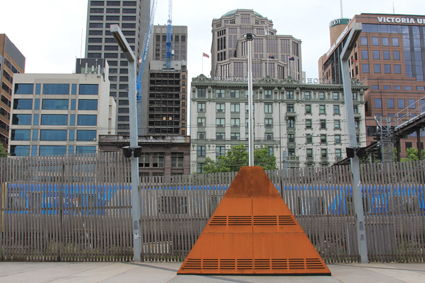
Giant Theremin, Robin Fox
photo courtesy the artsist
Giant Theremin, Robin Fox
The Theremin has a kind of cult status in the electronic music world not just because of its otherworldly sci-fi sounds—it is perhaps the earliest manifestation of an interactive installation. Russian scientist Leon Theremin created an instrument that can be played by anyone simply by gesture— waving hands gracefully through air. Even today, amidst all our contemporary interactive devices it still seems a little bit magical. So imagine the potential of an upscaled Theremin, designed as a public artwork. The City of Melbourne has approached Robin Fox to create this wonder and it has just been unveiled in Signal Forecourt, Northbank. (Fox is perhaps best known for his astounding interactive audio visuals created with Frieder Weiss for Chunky Move’s Mortal Engine, see reviews in RT88 and Dance Massive 2009 coverage.) Standing seven metres tall, the instrument responds to the movements of people around it, and is able to produce not only original Theremin sounds but also to manipulate sound files and trigger midi-instruments. Fox says “it is designed to make people move and to make people listen, not only to their own sound but to the sound of others engaging with the instrument” (artist’s statement). The Giant Theremin will be integrated into a range activities over summer, including performances by music producer Dexter and a dance work by Stephanie Lake on Nov 26, and will be available for play until February. City of Melbourne, Robin Fox’s Giant Theremin; http://www.melbourne.vic.gov.au
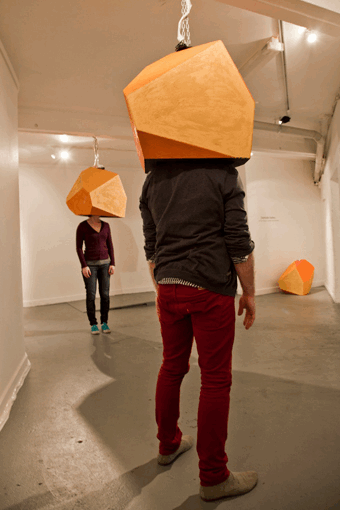
Cara-Ann Simpson, Geo Sound Helmets, 2011
photo Emily Hlavac-Green
Cara-Ann Simpson, Geo Sound Helmets, 2011
Over at Kings ARI, Cara Anne Simpson will bring the world to you with her Geo Sound Helmets. Using field recordings sourced from Melbourne, Singapore, Hong Kong, London, Toronto, Istanbul, Dunedin and her family farm in south-east Queensland, Simpson has created sound environments which play through head-encasing helmets and are controlled by the wearer’s breathing. The delicate sensors systems and headwear have been created in collaboration with James Laird (biomedical engineer and hacker), Ben Landau (industrial designer) and Eva Cheng (electrical and computer research engineer) and allow the listener a highly personalized journey through new aural geographies. (See Studio for Simpson’s previous work Noise Cancellation). Geo Sound Helmets Cara Anne Simpson , Kings ARI, Nov 25-Dec 17; http://www.kingsartistrun.com.au/kingsartistrun/upcoming/
The Out Hear Festival will also offer immersive sound experiences, but of a more acoustic nature. Dale Gorfinkel (see recent coverage in RT104, and earbash) has been artist in residence at the Footscray Art Centre and has also curated a weekend of deep listening events including installations, kinetic sound sculptures and instruments, performances and sound walks. Joining him will be guest artists Joyce Hinterding , Ernie Althoff, Rikki-Metisse Marlow, Ross Manning, Matt Chaumont and Anthony Magen. Out Hear Festival, curator Dale Gorfinkel, performance evening Nov 25, 8pm; Big West Festival weekend installations Nov 26 & Nov 27 11am-4pm; Footscray Arts Centre; http://outhear.com/; http://footscrayarts.com/
beijing bound
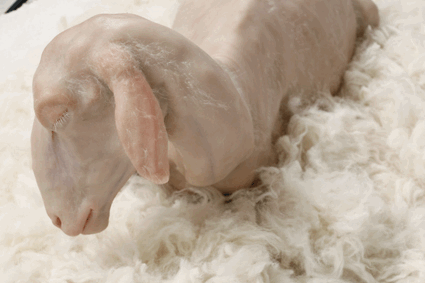
Shen Shaomin, I sleep on top of myself, detail of production image and installation shots, 4A Centre for Contemporary Asian Art
courtesy of the artist
Shen Shaomin, I sleep on top of myself, detail of production image and installation shots, 4A Centre for Contemporary Asian Art
Shen Shaomin, the artist who brought us Bonsai, the eerily life-like silica replicas of communist leaders in the 2010 Sydney Biennale, has returned to Australia to present his first solo exhibition in 10 years, The Day After Tomorrow at 4A Centre for Contemporary Asian Art. The exhibition will feature his most recent work which presents disturbingly hairless animal replicas in mounds of salt “dramatising the impact of human evolution and culture, and the damage inflicted upon the natural world and amongst its own species, in the pursuit of human freedom and progress” (website). As well as the gallery’s recent success in securing multi-year funding status as a Key Organisation, 4a has also announced a new opportunity for 2012 in which an Australian artist will be in residence at Shaomin’s studio complex in Beijing. Director Aaron Seeto states, “Shen Shaomin has been thinking very deeply about the type and quality of support that can be offered to Australian artists, and he has very generously offered his own studio as this cultural bridge” (press release). Shen Shaomin, The Day After Tomorrow, 4A Centre for Contemporary Asian Art, Nov 15-Dec 10. Application details for the 2012 Beijing residency will be announced in December; http://www.4a.com.au/coming-soon-shen-shaomin-the-day-after-tomorrow/
future food
Given the current obsession with curious cuisine, it’s no surprise that some artists are incorporating the culinary into their practice. Australian-born US based Natalie Jeremijenko is a leading artist working with science and environmental issues and over the next two weeks she will be combining ecological thinking with haut-cuisine as she presents her Cross(x)Species Adventure Club in Sydney, Melbourne and Avoca (regional Victoria). Jeremijenko and chef Mihir Desai have been presenting the “eco-inspired ‘supper club’” around galleries in New York, creating dining experiences that illustrate “how choices in how and what we consume can have direct effects on ecological systems and the species that exist within them” (press release), with the proceeds helping support her Environmental Health Clinic (xClinic) at New York University. Cross(x)Species Adventure Club will be presented for one night only, Dec 1, at the Melbourne Museum, where guests will experience “edible cocktails that each stylishly and humorously explore our gastronomic, economic and material interdependency on other creatures” (press release). There will also be an exclusive Cross(x)Species degustation dinner at ArcOne Gallery on Nov 30. Prior to the Melbourne leg of the tour Jeremijenko has also appeared in Sydney for the National Institute of Experimental Art’s Curating Cities: Sydney-Copenhagen conference at Customs House. Aspects of her Farmacy project, with suggestions as to how to become an urban farmer or uFarmer, will be on display as part of the accompanying exhibition. Carbon Arts presents Natalie Jeremijenko’s Cross(x)Species Adventure Club; see website for full program details; http://www.carbonarts.org/events; NIEA’s Curating Cities: Sydney-Copenhagen, Nov 17- Dec 18, Customs House, Circular Quay; http://curatingcities.org/exhibitions/curating-cities-sydney-copenhagen/
fotofreo fringe proposals
Western Australia’s biannual photographic festival is coming up in March-April 2012 and planning is well underway. As well as major commissions by Martin Parr exploring Broome, Port Hedland, Fremantle and Albany and Bo Wong capturing the essence of Fremantle Market, there will also be a focus on photography from India and a group exhibition from New Zealand. The fringe festival is currently calling for submissions with a deadline of Nov 30. http://www.fotofreo.com/programme/fringe-exhibitions
RealTime issue #105 Oct-Nov 2011 pg. web
© RealTime ; for permission to reproduce apply to realtime@realtimearts.net
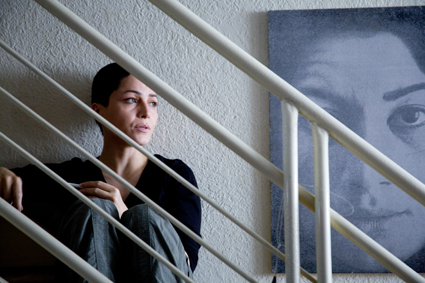
Marzieh Vafamehr, My Tehran for Sale
FOR ALL THE AUSTRALIAN PRESS COVERAGE OF THE 90 LASHES AND YEAR IN JAIL HANDED TO IRANIAN ACTRESS MARZIEH VAFAMEHR IN OCTOBER, SURPRISINGLY LITTLE ATTENTION HAS BEEN PAID TO THE FILM THAT CAUSED ALL THE TROUBLE, THE AUSTRALIAN-IRANIAN CO-PRODUCTION MY TEHRAN FOR SALE.
Nor has there been much reflection on the fact that the film failed to get a local release, despite playing at numerous festivals around the globe and winning the 2009 IF Independent Spirit Award. Although local distributors have remained indifferent, My Tehran for Sale is one of the most complex, engrossing works made in Australia for some time. It not only provides a quietly dramatic insight into what it’s like to live under the constraints of a theocratic regime—it also holds up a mirror to our own inhumanity in the face of those escaping repression in Iran and other countries.
The film’s Iranian director Granaz Moussavi comes from a Tehran family with deep roots in the Iranian film world and she continued to pursue her own passion for cinema after moving to Australia in 1997. Filmed entirely on the streets of Tehran with Australian financing (including support from the Adelaide Film Festival, see RT102), My Tehran for Sale is an attempt to reclaim a city and an artistic tradition that has been systematically smothered by Iran’s theocracy—a love letter to a capital, shot through with mourning, melancholy and loss.
a subterranean world
My Tehran for Sale opens with two illicit gatherings—one out of the past, one stridently modern. The camera slowly pans from a gas lamp across the faces of children and teenagers sitting in a circle around a middle-aged man playing songs in a traditional style. Suddenly we cut to the frenetic bass-heavy beats of a rave, the children of Iran’s revolution dancing to a forbidden tune. Marzieh—played by the actress of the same name—is outside the dance party with her new boyfriend when the police descend. First they break up the acoustic sing-along, accusing the youths of being illegal Afghan immigrants, then they burst into the rave in the adjacent building, denouncing the brazen display of “immoral” behavior and arresting all those present. Marzieh hides as her friends are taken away in a bus, a position we shall see is symptomatic of a life lived in the shadows. In a scene unhappily presaging the actress’ own sentencing, the ravers are later flogged.
The focus of My Tehran for Sale is not the cruelties of the Iranian regime, however, but the vitality of life and artistic expression throbbing beneath Tehran’s surface. When she’s not attending raves or underground concerts, Marzieh is a member of an underground theatre troupe, rehearsing performances behind closed doors and dreaming of one day reaching an audience. At private parties her friends smoke and recite poetry, all the while conscious of the stranglehold the authorities have over their city’s public life.
The emotional core of the film revolves around Marzieh’s budding relationship with Saman (played by the director’s husband Amir Chegini), an Iranian-born Australian who has returned to his homeland looking for business opportunities and perhaps someone to save. Although Saman potentially offers a way out of Iran, Marzieh is torn between her love for her culture and a desire to escape the crushing weight that hangs over her existence.
At a party, Marzieh asks a stoned Saman what Australia is like. “Can you perform there and does it get recognised?” she asks plaintively, the naivety of her question painfully obvious to an Australian audience. Saman paints an idyllic picture of a nation bathed in light and replete with material wealth, but lacking depth. “Australia is like paradise. A paradise made of coloured paper,” he says dreamily. Describing his arrival in Australia at age 14, he recalls, “You get on a plane, you cross seas, oceans. You arrive in a big city full of light. Just like a fairytale. But after a couple of weeks, the effect is gone. And you start to wonder, who are these people, what is this place?” The monologue deftly evokes the conflicted emotions of the forced emigré caught between memories of a lost homeland and the reality of life in an alien culture.
As it turns out, Marzieh’s entry into Australia is considerably less smooth than Saman’s. Throughout the film the actress’ subterranean life in Tehran is intercut with snippets of interviews between her and an unsympathetic immigration official in an Australian detention centre. Apart from dramatic tension—how did Marzieh end up in this place?—the cross-cutting creates disturbing parallels and repetitions between the two settings.
Repression here is not something that can be comfortably ascribed to the ‘other,’ as we watch from the West, confident of our own freedoms. My Tehran for Sale subtly affirms that arbitrary state power also ruins lives right here in Australia, through policies supported by many and enforced by our own public servants. It’s this skillful movement between time zones and places that makes Moussavi’s film such a rich, evocative portrayal of individual lives caught in the constricting binds of others’ fear and ignorance—whether it’s the religiously-inspired intolerance of the Iranian government or the suffocating bureaucratic stonewalling of Australia’s refugee processing system.
a community under a cloud
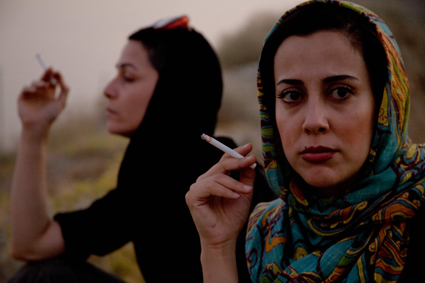
Marzieh Vafamehr, Asha Mehrab, My Tehran for Sale
Life depressingly imitated art in July this year, when actress Marzieh Vafamehr was arrested in Iran for her role in My Tehran for Sale. In early October she was sentenced to 90 lashes and a year in jail. The charges related to scenes in which she appears without hijab, although previously this had been permitted in Iranian cinema when a woman’s head was shaved, as Vafamehr’s is in the film. In fact director Granaz Moussavi stated in an ABC interview on October 11, “I didn’t do anything wrong in the film according to the rules and regulations of filmmaking in Iran.” In any case, the film was never intended for the Iranian market. Pirate DVD copies gradually seeped into the country, however, and it also became available on various websites. By mid-2011 it seems the Iranian authorities felt compelled to respond.
Vafamehr’s sentence provoked widespread international criticism and was appealed by her lawyers. On October 28 it was reported that the actress’ punishment had been reduced to three months imprisonment, with no corporal punishment. As Vafamehr had already been detained for four months, she was immediately released.
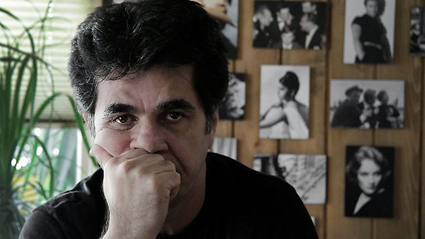
Jafar Panahi, This Is Not a Film
Unfortunately Vafamehr’s case is part of a wider campaign to intimidate film and media workers. In September six Iranian documentary makers were arrested for supplying material to the BBC. Two have since been released, while the fate of the other four remains unknown. In October, the acclaimed director Jafar Panahi (best known in Australia for The Circle, 2000) lost his appeal against a sentence of six years in prison and a ban on all filmmaking, international travel and contact with the press for 20 years. Panahi was initially arrested in July 2009 for his vocal support of protesters killed following Iran’s disputed presidential election. Soon released, he was rearrested in February 2010. His colleague, director Mohammad Rasoulof, was arrested at the same time and also sentenced to six years in prison, recently reduced to one. Jafar Panahi’s documentary This Is Not a Film, smuggled out of Iran on a USB stick after being shot by the director on a mobile phone while under house arrest, is currently screening in most capitals around Australia.
This litany of arrests shows that while Marzieh Vafamehr has thankfully been released, a very dark cloud continues to hang over Iran’s celebrated filmmaking community. Even Abbas Kiarostami, widely regarded as one of the greatest filmmakers of contemporary times, feels he can no longer work in his home country. His most recent film was made in Italy, and his next production is planned for Japan. On German radio he recently stated Iranian filmmakers face a “very, very bad situation.” In the case of director Granaz Moussavi, Iran’s loss has been Australia’s gain. Let’s hope local indifference doesn’t stifle a voice that the Iranian authorities have attempted to cow through more coercive means.
My Tehran for Sale is available on DVD from Vendetta Film; www.vendettafilms.co.nz
My Tehran for Sale, writer, director Granaz Moussavi, producers Julie Ryan and Kate Croser, actors Marzieh Vafamehr, Amir Chegini, Asha Mehrabi, Cyan Films, Australia-Iran, 2009
Jafar Panahi’s This Is Not a Film will be reviewed in RT107
This article first appeared in the online e-dition Nov 22
RealTime issue #106 Dec-Jan 2011 pg. web
© Dan Edwards; for permission to reproduce apply to realtime@realtimearts.net
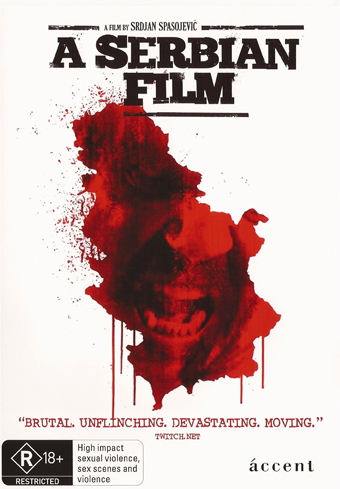
A Serbian Film (before banning)
WHILE NOTORIOUS FOR ITS EMPHASIS ON SIMULATED SEXUAL VIOLENCE, SRDJAN SPASOJEVIC’S 2010 A SERBIAN FILM USES SHOCK AND REVULSION AS AN ALLEGORY FOR THE VIOLENCE OF THE STATE. FOLLOWING THE COLLAPSE OF THE SOVIET BLOC SOME FORMER EASTERN EUROPEAN COUNTRIES, INCLUDING SERBIA, SAW OUTBREAKS OF VIOLENCE AND CIVIL WAR ALONGSIDE ETHNIC AND RELIGIOUS CONFLICT AND VARIOUS FORMS OF STATE OPPRESSION. THE FILM’S NARRATIVE DEPICTS SEXUAL VIOLENCE, BUT THE TITLE, WHICH IS REMOVED FROM ANY FAMILIAR HORROR OR PORNOGRAPHIC LEXICON, IS INDICATIVE OF A WIDER SENSE OF POLITICS.
In a statement on the film’s website Spasojevic states: “The initial idea was to make a film which would incorporate our desire to make an honest and unflinching depiction of the political and emotional turmoil that governed our lives in Serbia during the last two decades of wars and transition, but also to merge that ambition with the wish to make a philosophical, confrontational genre film which would transcend those agendas into a piece of cinema that we had always wanted to make. We didn’t want to make a hermetic picture that would deal exclusively with our local tragedies, but to tell a story with global overtones, because Serbia is merely a reflection of the ways of today’s New World in general, as it tries to imitate it and fails miserably” (http://aserbianfilm.co.uk/statement.html).
This is not to diminish those films that have no politics or that embrace the spectacle of violence simply for its own sake—these too have a place in cinema. The point is merely to indicate an apparently more considered engagement with extreme material within A Serbian Film than some have allowed.
Following an international release (including the UK and USA) in August 2011, an edited version of A Serbian Film was released domestically under an R18+ classification. However South Australia’s Attorney General John Rau banned the film on the recommendation of the state’s classification board. For Rau the film was beyond description and, by implication, discussion: “Some of the scenes in the DVD are so depraved that I am not prepared to even describe them in any detail. Suffice to say that some of the most disturbing scenes involve children, including an infant” (http://www.adelaidenow.com.au). The politician pursued a similar line on ABC Radio’s PM, where he stated he was “revolted as any decent thinking person would be” (http://www.abc.net.au). Such rationale is dangerously simplistic: it implies that if somebody wanted to watch the work then his or her interest should be considered suspect.
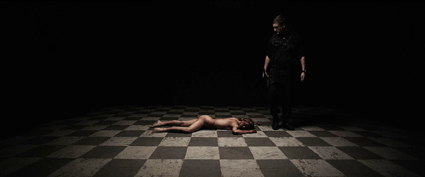
A Serbian Film
These events did not go unnoticed and the Federal Minister for Justice Brendan O’Conner applied for a Classification Board Review. Melinda Tankard Reist, a ‘pro-life feminist’ representing Collective Shout—“a grassroots campaigning movement against the objectification of women and sexualisation of girls in media, advertising and popular culture” (http://collectiveshout.org)—also made a submission calling for a review. Once again the film was assessed, but now it was deemed unsuitable and refused classification (RC). Collective Shout proudly announced this as a “Win!”
Existing as a separate legal entity from the Classification Board “the Classification Review Board is an independent statutory body whose members are chosen from a range of backgrounds to broadly represent the Australian community” (http://www.ag.gov.au). At the time of writing the board consists of four women, three of whom have law degrees while the fourth is a psychologist. Three members of the Review Board banned A Serbian Film.
While they acknowledged the reading of the film as allegorical their report states that this is primarily manifest in the publicity, with the narrative making the connection between the abuses on screen and wider events only once (Classification Review Board report, Review 19 September 2011, “Reasons for the decision”). This suggests a failure to understand the nature of allegory; moreover it fails to appreciate that the film’s title alone should draw attention to its wider intent. Contemporary audiences do not stumble across a film devoid of context and most viewers would be familiar with the discourses that surround the work.
Without drawing aesthetic comparisons it should be apparent that, like Pasolini’s Salo—that other bugbear for Australian censors—the depravities and psychological abuses of power find their metaphorical manifestation in sexuality and sexual violence. Primarily because the chaos, confusion and breakdown/construction of psychological inhibition associated with sex makes it the perfect arena for allegories of social and ethical fragmentation.
The Review Board is designed to reflect community standards. However, exactly which community is never stated; Australia is a multicultural society and as such has a plurality of communities, each with their own standards. It appears that no member of the board is based in either Melbourne or Sydney, arguably the country’s most cosmopolitan cities, so their understanding of community standards may differ from, for example, an interested urban viewer who attends screenings at film festivals.
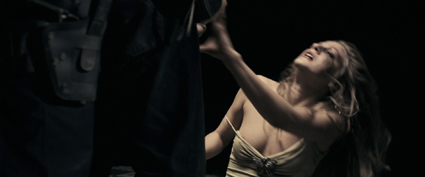
A Serbian Film
There is something unnerving about the contemporary discourses on film being dictated by politicians, conservative religious commentators, special interest groups and unelected bureaucrats. A work like A Serbian Film is designed to be grueling and unpleasant—nobody who has seen it has described it as ‘fun’—its horror belongs to contemporary fears of violence, of being both controlled yet out of control. It is not a film designed for simple pleasures but for confronting an audience. This may not be everyone’s idea of the role of cinema, but that is not the point. It is essential to remember that, as Philip Pullman stated, “no one has the right to live without being shocked. No one has the right to spend their life without being offended” (http://boingboing.net).
It could be argued that I am attempting to justify the offensive, but I am not interested in justification; ultimately that is a process of interpretation that should be up to each viewer of the film. However, the ability for audiences in Australia to make this judgement has been denied them.
Some may argue that A Serbian Film simply goes too far, is too offensive and is disgusting, but then, are the human rights abuses that it mirrors not offensive and disgusting? Artists can hardly be expected to make films that do not engage with this. Denying people the chance to listen to these artists’ voices will not make the violence go away, but it will inure local audiences to censorship’s sterile oppression.
breaking news
Just before going to print, another horror film Human Centipede 2 (to be reviewed in RT107) has been banned. In addition Collective Shout (one of the groups lobbying for the banning of A Serbian Film) is submitting recommendations to the National Classification Scheme Review Discussion Paper undertaken by the Australian Law Reform Commission (www.alrc.gov.au/sites/default/files/pdfs/cia_2477_collective_shout.pdf) calling for even tighter regulations. Changes include the unification of classification bodies into a single regulator; the removal of content types replacing with “platform neutral definitions of ‘media content’ and ‘media content provider’;” and the removal of the “exempt status” for content shown at film festivals, art galleries and other cultural institutions, which would have strong ramifcations across the arts sector. RT
A Serbian Film, director/writer Srdjan Spasojevic, writer Aleksandar Radivojevic, Contra Films, distributed by Accent Films
This article first appeared in the online e-dition Nov 22
RealTime issue #106 Dec-Jan 2011 pg. web
© Jack Sargeant; for permission to reproduce apply to realtime@realtimearts.net
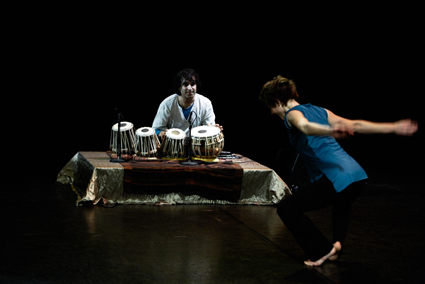
Bobby Singh, Miranda Wheen, Game On
photo Shane Rozario
Bobby Singh, Miranda Wheen, Game On
CROSS-CULTURAL COLLABORATIONS CAN YIELD A VARIETY OF OUTCOMES, DETERMINED BY INTENTION (LET’S AIM FOR SYNTHESIS OR JUXTAPOSITION) OR CHANCE (LET’S SEE WHAT HAPPENS). THE TITLE OF CHOREOGRAPHER ANNALOUISE PAUL’S GAME ON SUGGESTS, AS IN SPORT, A CHALLENGE WITH AN UNPREDICTABLE RESULT. WHAT HAPPENS WHEN “A 3,000 YEAR OLD CLASSICAL INDIAN MUSIC TRADITION MEETS A WESTERN CONTEMPORARY DANCE FORM, 100 YEARS YOUNG?”, ASKS PAUL IN HER PROGRAM NOTE.
The spatial structure of Game On, with tabla virtuoso Bobby Singh surrounded by his instruments on a low platform to one side of The Studio floor and dancer Miranda Wheen on the other, suggests a face-off, one that in the event unfolds in individual displays and then escalating episodes of interplay and good-humoured provocation and gentle mockery. The result is not a hybrid (of the kind you might expect from, say, Akram Khan and his various collaborators) but a conversation between two forms that very much retain their own shape and integrity while driving each other to new rhythmic extremes and subtleties.
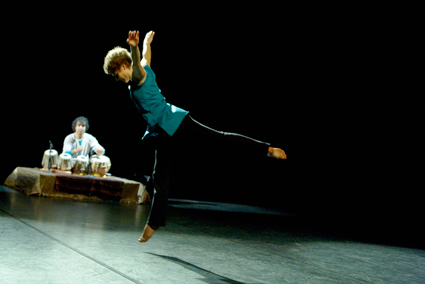
Bobby Singh, Miranda Wheen, Game On
photo Shane Rozario
Bobby Singh, Miranda Wheen, Game On
The work’s dramaturgical structure suggests improvisation with its casual pauses, smattering of chat and the artists’ turn-taking at triggering episodes, or when it’s clear, for example, that Wheen has been fully extended and is happy to rest as Singh shapes material for the next encounter or plays a solo she does not respond to. At the outset the improvisational gestures and tone feel somewhat forced, as if prepared instead of spontaneous, making the early part of Game On feel too tentative for too long.
What is never in doubt is the spirit and expertise of the performers. As an audience member commented, it was wonderful to hear Singh uncharacteristically playing without other musicians, allowing us to fully focus on the timbral range and surprising harmonics he can draw from his variously sized tabla. Wheen met Annalouise Paul’s considerable choreographic challenge and Singh’s rhythmic demands with total fleet-footed commitment, working much of the stage space with fully extended limbs, floor spins and rolls, long leaps and ripples that flowed through her body. The response to rhythmic change was never literal, neither artist simply speeding up because the other was moving or playing faster, instead producing a marked visual or sonic counterpoint.
In the passage that most fully engaged me, Wheen danced very close to Singh with movements that lowered her centre of gravity, legs bending deep, knees out, arms extended, hands articulated as if to suggest an Asian influence in a moment of suggestive if doubtless impressionistic cultural synthesis given that Wheen was not literally imitating Indian dance. Game On proved to be an intriguing experience if an uncertain one about precisely where Indian music and western dance might actually meet. Nonetheless Annalouise Paul’s Theatre of Rhythm and Dance offers the promise of further worthwhile and much needed cross-cultural explorations drawing on the skills and passions of talented artists.
Theatre of Rhythm and Dance, Game On, choreography, concept Annalouise Paul, choreographic collaborator, dancer Miranda Wheen, classical Indian tabla Bobby Singh, musical dramaturgy Peter Kennard, lighting Stephen Hawker, costume Jai Saunders, producer Sam Hawker, Arts Radar; The Studio, Sydney Opera House, Aug 13-15, www.annalouisepaul.com.au
RealTime issue #105 Oct-Nov 2011 pg. web
© Keith Gallasch; for permission to reproduce apply to realtime@realtimearts.net
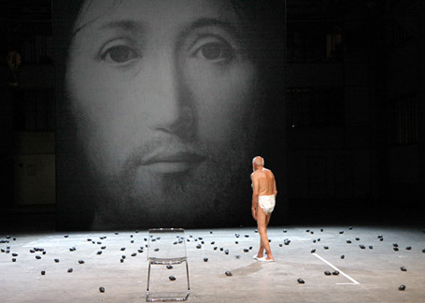
Gianni Plazzi, Sul concetto di volto nel figlio di Dio (On the Concept of the Face of God), Socìetas Raffaello Sanzio
photo Klaus Lefebvre
Gianni Plazzi, Sul concetto di volto nel figlio di Dio (On the Concept of the Face of God), Socìetas Raffaello Sanzio
fundamentals of free speech
Following recent attempts by fundamentalist elements of the Hindu community to censor the presentation of Back to Back’s Ganesh Versus the Third Reich in the Melbourne International Arts Festival, comes an attempt by far-right fundamentalist Catholics to shut down Socìetas Raffaello Sanzio’s Sul concetto di volto nel figlio di Dio (On the Concept of the Face of God), directed by Romeo Castellucci at the Théâtre de la Ville in Paris. As reported in CultureBot, the performance centres on a man caring for his dying father with a visceral depiction of bodily incontinence. At one point the son cleans up the shit-smeared floor in front of a projection of Christ by Renaissance painter Antonello de Messina. After losing a legal battle for an injunction on the grounds of anti-religious discrimination, the group calling itself the Alliance Against Racism and for the Respect of French and Christian Identity (thought to be connected to the Civitas Institute responsible for an April attack on Andres Serrano’s Piss Christ), has protested at the theatre, throwing stink bombs, engine oil and eggs onto queuing audiences and interrupting performances.
The theatre has issued a statement condemning the protests, stating “these behaviours are clear manifestations of fanaticism, that enemy of enlightenment and freedom against which, in glorious times, France has so successfully fought” (cited in Jeremy. M. Barker, Culturebot Far-Right Activists Try to Shut Down Theater Production in Paris, Oct 27). It has also issued a manifesto “Le Théâtre contre le Fanatisme” (“Theatre against fanaticism,” in French only), signed by notable French and international artists. A spokesperson for the French Catholic Church has also condemned the protests but calls for “free speech that respects the sacred.” The irony is that the work of Romeo Castellucci arguably creates theatre that is deeply religious and sacred, rethinking and recreating these concepts for contemporary contexts. Castellucci told Le Monde, the play is “in no way blasphemous or Christianophobe…but these activists can’t know that because they haven’t seen it.” (His statement, in French can be found here). It’s another example in a disturbing trend of knee jerk fundamentalist protest in which the work is not approached in context and in which interpretive, contextual and analytic thinking are overruled by dogma. (Key sources CultureBot; RFI; The Guardian)
good, clean fun
Multimedia performance group PIPS:Lab started ten years ago, growing out of the underground party scene in Amsterdam. According to their manifesto “a PIPS:lab project must always include multiple art forms, the audience must be involved using interactive techniques, fiction and reality are mashed up, the footage is always recorded live, high tec (sic) is made low brow, all elements of a show or installation (like wires, cables and screens) are visible on stage” (website). In November they will be bringing their high-energy theatre of the absurd to Australia, presenting The Washing Powder Conspiracy at Serial Space in Sydney and also at the Awesome International Arts Festival in Perth.
PIPS:Lab have extensively toured Europe with works such a Wortal Combat 3, an interactive game show where the audience assists the heroes to win the love of Lara Croft (chosen from the viewers each night) and including a larger-than-life version of the computer game Pong. They have also created the Lumisol concept in which participants, live on video paint with light to create an installation or a performance with leading graffiti artists. The Washing Powder Conspiracy focuses on live video editing and music made from non-conventional instruments like irons, washing machines and laundry baskets and “casually flirts with themes like democracy, capitalism, commercials and war” (website). Australian artist Fred Rodrigues, creator of the SMS Interactive Music System (S.I.M.S) (reviewed here) and the Heavy Metal Work Orchestra in which power tools improvise with musicians has been working with PIPS:Lab for the last year. PIPS:Lab, The Washing Powder Conspiracy, Serial Space, Sydney, Nov 11-12, free workshops Nov 13-14, http://serialspace.org; Awesome Arts, PICA Perth, Nov 21-27 http://www.awesomearts.com/festival; http://www.pipslab.org
moving moments
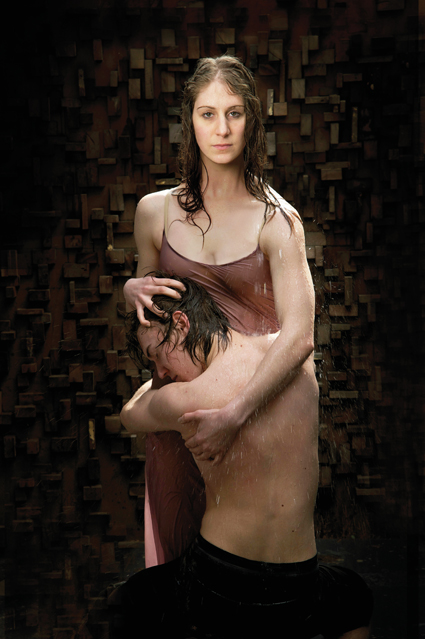
Shiver, Danielle Micich
photo Ashley de Prazer
Shiver, Danielle Micich
Performing Lines WA was established in 2008 as an offshoot of the Sydney-based organisation to undertake the Managing and Producing Services (MAPS) for Western Australia. It produces for five core artists/companies: Chrissie Parrott Performance Company, Sally Richardson, pvi Collective, Sue Peacock and Marrugeku. In addition it takes on key projects from independent artists and will soon be presenting Danielle Micich’s Shiver (to be reviewed in RT107). Micich was previously a director of STEPS Youth Dance Company and has already had a busy year creating a work for Buzz Dance Theatre, choreographing for a new contemporary opera, Into the Shimmer Heat, in which the lead role is danced, not sung, and participating in Force Majeure’s Cultivate Lab. Renowned for her emotive approach to dance, Micich in Shiver “explores the gamut of human emotion experienced by four people faced with loss” (press release) using the dancers’ own stories as starting material. The cast includes Gerard Van Dyke from Melbourne’s KAGE Physical Theatre, with sound by Kingsley Reeve. Worth a look is the detailed blog that follows the development of the project. Performing Lines WA, Shiver, director Danielle Micich, performers Jacqui Claus, Lewis Kilpatrick, Leanne Mason, Gerard Van Dyck, sound Kingsley Reeve, lighting Joseph Mercurio; The Dolphin Theatre, University of WA, Crawley, Perth; Nov 17-19; http://www.performinglineswa.org.au/view/Shiver/
In South Australia, Restless Dance Theatre is presenting Debut 3—the dancers direct, in which three company dancers choreograph their own works. Working with the theme “the butterfly effect” the choreographers, Andrew Pandos, Jianna Georgiou and Lorcan Hopper, will be mentored by guest artists to develop their works. This is the third incarnation of Debut, with previous editions proving very popular, so booking is recommended. Restless Dance Theatre, Debut 3¬—the dancers direct, The Restless Studio, 234a Sturt St, Adelaide, Nov 11-12; http://restlessdance.org
reconciling voices
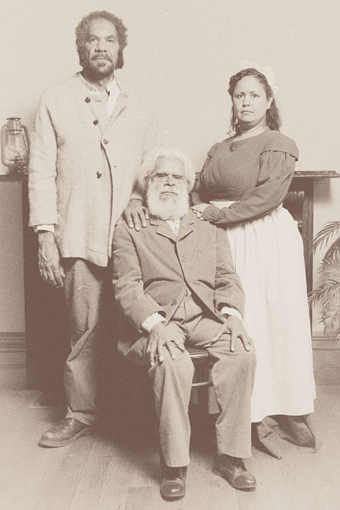
Greg Fryer, Uncle Jack Charles (seated) and Melodie Reynolds, Coranderrk: We Will Show the Country, Ilbijerri/The Minutes of Evidence Project/La Mama
photo Steven Rhall
Greg Fryer, Uncle Jack Charles (seated) and Melodie Reynolds, Coranderrk: We Will Show the Country, Ilbijerri/The Minutes of Evidence Project/La Mama
In Sydney at Performance Space we have the long awaited Posts in the Paddock by My Darling Patricia and Moogahlin Performing Arts (previewed in RT105 ). In Melbourne, Ilbijerri Theatre Company, The Minutes of Evidence Project and La Mama will present Coranderrk: We Will Show the Country. Based on the actual minutes of evidence from the Coranderrk Enquiry in 1881, the show gives voice to both the Aboriginal and non-Aboriginal people who took on the Board for the Protection of Aborigines in order to determine the future of the Coranderrk Aboriginal Station. Coranderrk: We Will Show the Country “unites the power of oral history and the authority of the written word to forge a personal connection with the voices of the past” (press release) and includes testimony from key figures such as William Barak (see RT review of the recent NGV Barak commissions). Based on a concept by Giordano Nanni, with texts adapted by Nanni and Andrea James, Coranderrk is directed by Isaac Drandic with dramaturgy by Rachael Maza Long and features an impressive cast including Jack Charles (see reviews of Bastardy; Jack Charles V The Crown; and performance group Nightshift, Syd Brisbane, Jim Daly, Peter Finlay, Greg Fryer, Liz Jones, Tom Long, Melodie Reynolds and Glen Shea. The project is the work of extensive research thanks to a number of supporting partners such as the Australian Research Council, The Koorie Heritage Trust, The University of Melbourne,The State LIbrary of Victoria, The Victorian Aboriginal Education Association Inc, and various state government agencies covering arts, health, education and regional arts. Ilbijerri Theatre Company, The Minutes of Evidence Project and La Mama, Courthouse Theatre, Nov 16-27; http://lamama.com.au/now-showing/spring-programme/coranderrk-we-will-show-the-country/
pretty women
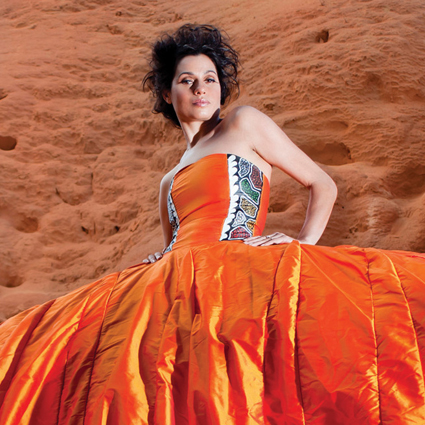
Flash Women, Juliette Knox in her Uluru dress, 2010, designer Yaneira Velasquez
photo Sam Walker
Flash Women, Juliette Knox in her Uluru dress, 2010, designer Yaneira Velasquez
The State Library of Queensland has just opened Flash Women, an exhibition celebrating Aboriginal and Torres Strait Islander style through photos and items of clothing worn by leading Indigenous women. Artist Walbira Murray writes, “Aboriginal and Torres Strait Islander women possess immense grace and beauty, although it’s often not celebrated in mainstream Australia. We are beautiful because we have the ability to rise above severe adversity and triumph over challenge” (website). The exhibition features items from a diverse range of women including jewellery and a cameo brooch from elder Aunty Ruth Hegarty, entrepreneur Juliette Knox’s Uluru dress and Raelene Baker’s Miss OPAL 1970 dress, sash, gloves and purse. While Flash Women is a celebration of fashion, it also serves to tell the lesser known stories of some of Australia’s inspirational women. Through Facebook, people can also send in photos of their own flash ladies to become part of the display. Flash Women, kuril dhagun Indigenous Knowledge Centre, level 1, State Library of Queensland; Nov 1 – Feb 24, 2012; http://www.slq.qld.gov.au/whats-on/events/flash
on the move
The Australia Council is undertaking an extensive consultation process in order to develop a framework for national touring. Consultants Rick Heath and Harley Stumm will be heading around the country over the next few months to gather feedback from artists and companies. The initiative aims to both map the current touring landscape and develop access to pathways and information, and also look to the future of touring in Australia. Consultation dates: Victoria, Nov 9, 10, Tasmania Nov 11, Darwin Nov 22, Adelaide Nov 24, 25; Cairns Dec 2; Brisbane Dec 5, 6; Sydney Dec 7, 8; Perth Dec 12; APAM workshop Adelaide Feb 27; Long Paddock Albury Wadonga April 3, 4. Register your interest to receive updates & further information with Katie Harford, Program Officer Market Development, email k.harford@australiacouncil.gov.au; or phone 02 9215 9041.
RealTime issue #105 Oct-Nov 2011 pg. web
© RealTime ; for permission to reproduce apply to realtime@realtimearts.net
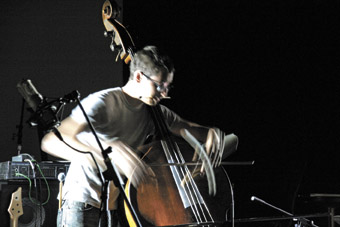
Clayton Thomas, the NOW now Festival
photo Tom Banigan
Clayton Thomas, the NOW now Festival
The spontaneous moments of the NOW now festival have been well documented in the print and virtual pages of RealTime. Reading through the almost annual reviews of this unique music festival (missing only the 2002 and 2004 manifestations), there is a tangible sense of growth and development in the event which reflects the evolution of the experimental music community itself, not just in Sydney but with national resonances.
As noted by Shannon O’Neill in his review of the 2006 festival the phrase ‘the now now’ is from renowned UK guitarist Derek Bailey, a personal hero of festival founders Clayton Thomas and Clare Cooper. In an interview at the end of 2002 Thomas talks of the festival’s development from the fortnightly series (awkwardly titled If you like improvised music we like you) into a large scale event. He also talks of the partnership with Melbourne’s regular improv event Make It Up Club to present a range of national and regional tours. It was clear from the start that these two young artists were passionate and ambitious about integrating “non-idiomatic improvisation,” to quote O’Neill, into the musical landscape of Australia.
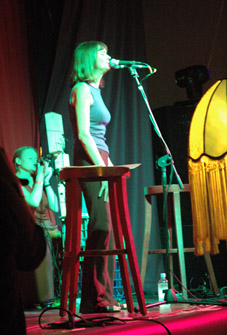
Natasha Anderson & Amanda Stewart
photo Clare Cooper
Natasha Anderson & Amanda Stewart
Two factors have been key to the event’s longevity: inclusiveness—an emphasis on developing a community—and flexibility. This has meant that the festival has been able to undergo changes and keep re-inventing itself. After outgrowing the artist-run galleries of Space 3 and Lan Franchi’s in Redfern, the curators took a very bold step in 2005, especially considering the lack of funding, by presenting the festival in the realtivelly mainstream rock venue of @Newtown. This leap of faith paid off as the accessibility of the venue dispelled any notion of clique-iness, attracting a much wider audience with over 300 people attending each night of this and the following festival. In an opinion piece in 2005 Caleb Kelly discussed this development and the shifting musical territory stating, “What provided the most excitement for the future of the scene was the willingness of this audience to try something new—four nights of Australian experimental music with no ‘big names,’ simply the promotion and celebration of Australian improvised musics. The Now now has taken over from What is Music? as the focus of the experimental music year in Sydney, from the point of view of both musicians and audience.”
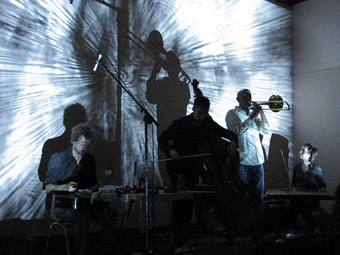
Zeit Kunst 6
photo Sam James
Zeit Kunst 6
Another shift occurred in 2008 when Thomas and Cooper relocated to Berlin, handing over the event to the community they had nurtured. A small collective of artists have successfully run the festival and the regular series (renamed The NOW now series) ever since. Feeling like the event might have reached its peak in the city, the collective opted for a tree-change, moving it to Wentworth Falls for 2008, 2009 and 2010. While this altered the scale of the event, it opened it out to other presentation modes, with a more site-specific focus including concerts in caves, sound walks and an annual curiosity from Jon Rose such as his interactive kite flying and musical netball concert. It also continued to attract the dedicated city audience along with the local community with Shannon O’Neill commenting of the 2008 event: “Alongside the familiar faces were hippies, parents with children and the elderly. The local community was curious and keen.”
The festival returned to the city in 2011 making use of the new batch of artist-run spaces and 2012 looks to continue this model. The NOW now is perhaps most impressive because, amongst all the format, venue and co-ordinator changes, what has remained constant is the passion for improvised music defined in its broadest sense. Experiencing the NOW now for the first time in 2003 I wrote: “Improvising is a valiant and foolish attempt to capture each moment, feel each slice of time as it passes over and through you. To do it right you have to surrender completely to the whims and vengeance of the temporal.” The festival is still around and successful because, it has responded like a kind of organism, in a similar way.
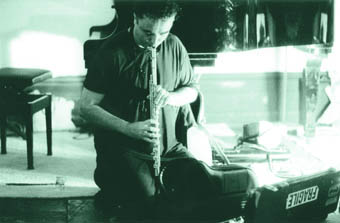
Jim Denley, the NOW now 2003
photo Joe Glaysher
Jim Denley, the NOW now 2003
Of course it’s not easy and Clayton Thomas summarises this in his 2002 interview: “I think improvised music and improvising in general—the freedom to bring to your ideas and expression and 100% of your energy to something—is really important. People are looking for that challenge: music as a model for life. It’s liberated and difficult and disciplined.” The NOW Now has definitely provided an inspiring model of freedom and rigor for the last 10 years, and we look forward to its future mutations.
The 2012 NOW now festival program will be launched Dec 14, 2011 at the Red Rattler. See www.thenownow.net for the schedule of regular events.
Gail Priest
2013
a spectrum of spontaneity
kate carr: now now festival 2013
RealTime issue #112 Dec-Jan 2012 pg. web
2012
borders down, camaraderie on
romy caen: 2012 now now festival
RealTime issue #108 April-May 2012 pg. 37
2011
delicacies, brutalities & inbetween
tony osborne: the now now festival 2011
RealTime issue #102 April-May 2011 pg. 38
part 2: sydney scenes & sounds
gail priest: the now now; sound series
RealTime issue #104 Aug-Sept 2011 pg. 48
2010
vigorous exercise & a well-balanced diet
gail priest: the now now festival 2010
RealTime issue #96 April-May 2010 pg. 39
2009
the improvising animal
gail priest: the now now festiva
RealTime issue #89 Feb-March 2009 pg. 39l
riding the impro wave
gail priest: fred rodrigues, S.I.M.S, the now now series
RealTime issue #94 Dec-Jan 2009 pg. 48
2008
relocation and reinvention
shannon o’neill takes to the hills for now now
RealTime issue #84 April-May 2008 pg. 41
2007
subtle assaults
tony osborne at the now now festival
RealTime issue #78 April-May 2007 pg. 42
2006
Impro: ethical, musical and now
Shannon O’Neill at the NOW now
RealTime issue #72 April-May 2006 pg. 30
2005
What NOW for experimental music?
caleb.k
RealTime issue #66 April-May 2005 pg. 48
the NOW now: present and accounted for
Gail Priest
RealTime issue #65 Feb-March 2005 pg. 42
2003
The NOW now: time slices
Gail Priest
RealTime issue #53 Feb-March 2003 pg. 45
2002
MAKE IT NOW: the impro revolution
RealTime talks to Clayton Thomas
RealTime issue #52 Dec-Jan 2002 pg. 39
RealTime issue #105 Oct-Nov 2011 pg. web
© Gail Priest; for permission to reproduce apply to realtime@realtimearts.net
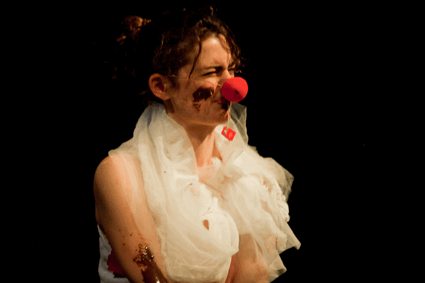
Alice Mary Cooper, Clown Lights Stage
photo Yann Audic
Alice Mary Cooper, Clown Lights Stage
LAST YEAR’S SYDNEY FRINGE FESTIVAL BOASTED SOME 200 SHOWS, PERFORMED IN THREE SUBURBS OVER TWO WEEKS, LEADING KEITH GALLASCH TO MUSE THAT IT “MAY WELL HAVE GAINED SUFFICIENT TRACTION TO GUARANTEE ITSELF A FUTURE” (SEE RT100 http://www.realtimearts.net/article/100/10122). AND INDEED IT HAS. THIS YEAR THE FESTIVAL GAINED ANOTHER 50 SHOWS, THREE SUBURBS AND AN ADDITIONAL WEEK.
With so many performances to choose from, I decided to navigate the festival via a venue—the PACT Centre for Emerging Artists in Erskineville—where I attended eight shows. Unfortunately I can’t cover them all here, so I’m focusing on the five solo works which dominated the program.
clown lights stage
Alice Mary Cooper arrives on the blackened stage wearing a white singlet and underpants and carrying a red handbag. “The good news,” she announces, “is that Alice is going to be okay; the other good news is that I am here to help.” Thus, with an air of slightly forced cheer, the clown starts to rifle through the contents of the absent Alice’s bag and then to perform her show. It’s hungry work, of course, and so she opens a jar of hazelnut spread only to misunderstand the instructions and smear the brown stuff all over her body. These markings remain as she discusses all things French, from Romanticism to French Onion dip, before delivering a rousing rendition of “Non, Je ne regrette rien” but with lyrics to include “baguette” and “croissant.” Elsewhere, she eats a teabag, has some misadventures with a tampon, and enacts most of the Greek tragedies. Balanced between the banal and the surreal, and performed with a very deft touch, Clown Lights Stage is truly delightful.
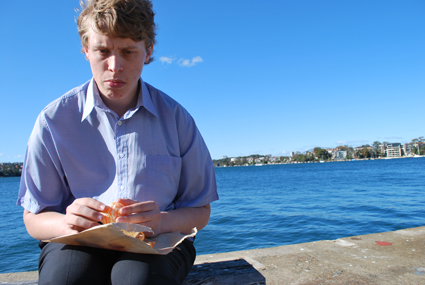
Nathan Harrison, The art and craft of approaching your head of department to submit a request for a raise
photo Rachel Roberts
Nathan Harrison, The art and craft of approaching your head of department to submit a request for a raise
the art and craft of approaching your head of department to submit a request for a raise
While you couldn’t call it clown, Nathan Harrison’s show also features a naïve protagonist negotiating an absurd world. Based on Georges Perec’s slim volume, which was published in French in 1969 and in English this year (!), The Art and Craft leads us through a series of increasingly unlikely scenarios as the protagonist advises on how to go about asking for that raise. Ten minutes into the performance and we have only just knocked on the boss’s door; it takes the remaining 40 minutes to canvass what sort of lunch to eat beforehand, how and when to sit down, what sort of small talk to make, when to fake comprehension and when to admit ignorance etc. The language is looping, repetitive and frustrating but there is clarity of purpose to both the writing and the performance. Together they come to resemble a flow chart in material form—an impossible attempt to account for every conceivable combination of events that could emerge and more besides. Harrison states that this is part of a larger project investigating performance structured by mathematical and scientific models, but it also reminded me of some of his work with Applespiel, specifically Executive Stress/Corporate Retreat (RT103). Like that performance, this one seems to speak to current workplace relations, where even government agencies spout corporate rhetoric, everyone is on rolling contracts and the unions negotiate deals where wages barely keep pace with inflation even as employers warn of an imminent skills shortage. For this reason alone, Harrison’s comic timing is impeccable.
gobbledygook
Bodysnatchers’ show lacks the conceptual clarity of Cooper and Harrison’s, but has some interesting moments nonetheless. Perhaps the most intriguing occurs when the protagonist (Aileen Huynh) has a phone conversation with her friend on the other end. When the conversation is over, it emerges that she has recorded it on her iPhone; she now replays the interaction but, this time, we hear the other part. This is where form and concept meet, but for the most part the phone serves merely as a prop and the performance risks becoming little more than an advertisement for its manufacturer. This lack of self-reflexivity, coupled with the redundant citation of philosopher Giorgio Agamben in the program notes, would seem to indicate that the artists haven’t fully resolved just what it is they want to say about phones, beyond the fact that they are part of the fabric of our lives.
dust
Thinking about the minerals that make our phones, and the possibility of reaching “peak minerals” in the same way that we have reached “peak oil,” provides an interesting background for Emeline Forster’s dance work. Taking its inspiration from the last man to leave a Queensland town before an open cut coal mine virtually swallowed it whole, Dust investigates the deadly pas de deux Australia now finds itself in with miners. Sections of slow rotating movement alternate with video footage of mines, towns and various products made with minerals. In the best sections, the two interact with Forster going behind the screens and playing with the combination of shadows and projections, so that she seems to stalk herself—an apt image indeed.
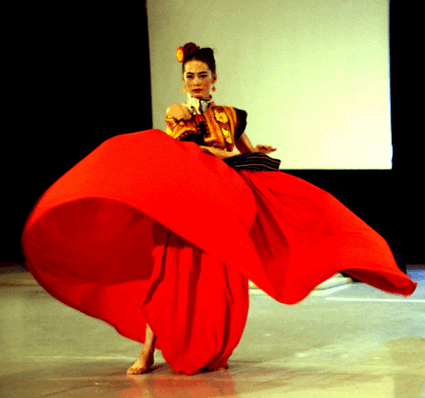
Meiwah Williams, Las Dos Fridas,
photos (standing) Roger Rossel, (seated) Ben Walsh
Meiwah Williams, Las Dos Fridas,
las dos fridas
Meiwah Williams’ Two Fridas is also full of compelling images (co-designed with Rachel Brown), starting with a white skirt suspended mid-stage, onto which is projected an image of a blue sky, white clouds and another white skirt. The effect is, appropriately enough, surreal. In another scene, Williams paints a piece of wax paper with water, slowly revealing one of Frida Kahlo’s self-portraits. The most magical moments are also the most acrobatic—Williams shimmying up the pink silks and tumbling down or when she executes a series of back flips in a full black skirt. While I initially wondered “why Frida, why now?,” the irresistible image of a dancing Kahlo wins me over.
3QUARED = 9 Fantastic Fabrications, Sydney Fringe@PACT; Clown Lights Stage, writer, designer, performer Alice Mary Cooper, dramaturg, mentor Michael Piggot, music Michael Meem; The Art and Craft of Approaching Your Head of Department to Submit a Request for a Raise, based on text by Georges Perec, devisor, performer Nathan Harrison, creative consultants Applespiel; Bodysnatchers, Goobledygook, director Mark Rogers, performer Ailenn Huynh, lighting Joseph Parro, sound design, composition Liam Halliwell, Jordan Thomson, dramaturg Sanja Simic; Dust, creator, performer Emiline Forster, video Emiline Forster, music Terry Hart, lighting Geoff Adams; Las Dos Fridas, performer, director Meiwah Williams, music Ben Walsh, visuals Rachel Brown and Meiwah Williams, vocals Maja Petrovna; PACT, Sydney, Sept 8-Oct 2
This article first appeared in the online e-dition Nov 8
RealTime issue #106 Dec-Jan 2011 pg. 33
© Caroline Wake; for permission to reproduce apply to realtime@realtimearts.net
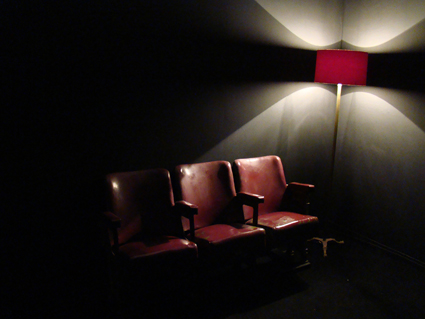
Christine Collins, I may have to see YOU again, Charlie
photo courtesy AEAF
Christine Collins, I may have to see YOU again, Charlie
INSTALLATION ART CONTINUES TO EVOLVE AS AN IMMERSIVE, CONFRONTING ARENA IN WHICH VIEWERS’ SENSE OF THE WORLD IS CHALLENGED AND THEIR PREDISPOSITIONS EXPOSED. THIS GROUP EXHIBITION AT AEAF COMPRISES TWO CONTRASTING ENVIRONMENTS INVOLVING HYBRID ARTFORMS, BUT THERE IS A COMMON DEVICE—THE VIEWER AS ACTOR RESPONDING TO ARCHITECTURAL SPACE AND COMPLETING THE ARTWORK.
In I may have to see YOU again, Charlie, Christine Collins has created a room within the gallery like a tiny cinema, but there is only a blank, black wall where the projected imagery would be. This is a work of sound art that uses fragments of Hollywood film soundtracks stripped of their visual elements, thus referencing rather than presenting cinema. The voice throughout is that of Charlton Heston, a career Hollywood actor who appeared in some epic films that defined a genre and shaped a culture.
Collins is interested in separating out elements of film for scrutiny, as she has done previously in work for the CACSA Contemporary 2010: The New New exhibition. Decontextualising these intense and disturbing lines both trivialises and immortalises them. Collins’ work celebrates the halcyon days of Hollywood cinema, and simultaneously questions Hollywood as an artform in itself. This work manifests as homage to Heston, but functions as incomplete conversation and is an exploration of language and its effects. Sitting as if to watch, we try to visualise the scenes, but we’re provoked to think verbally.
Many of the 18 characters Heston plays in these excerpts are historical figures—Moses, John the Baptist, Marc Antony, Michelangelo and so on. Collins’ catalogue essay is like a poem in which she paraphrases fragments of text as if they are statements made directly to her, colliding them to conflate the action. For example, “He [Heston] tells me he is a Florentine, a soldier, a shepherd, a Jew, a scientist, a narcissist, a civilian and sick of me,” and “He asks me if I have hot water, a reason, a gun and a report.” The quotations begin with I or you, establishing open-ended interpersonal exchanges. Collins’ positioning of herself as the respondent in these exchanges asks us how we would feel in the glare of Charlton Heston’s sometimes saintly, sometimes threatening masculinity.
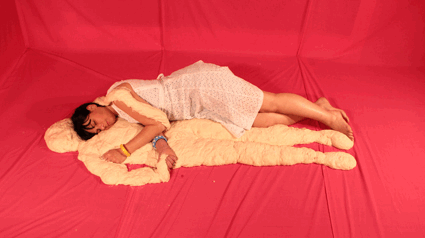
Ray Harris, Let me Go
video stills Ray Harris
Ray Harris, Let me Go
Outside this little cinema, Ray Harris’ installation Hold me Close and Let me Go consists of two videos projected on the gallery’s walls and a row of five large wooden crates, or small rooms, each a unique environment into which viewers are invited.
Harris is the actor in both videos: in one, she embraces a life-size human figure hewn roughly from ice; in the other, she cuddles another life-size figure, of soft, sticky pastry dough. Gradually she becomes covered in dough, unable to free herself, like a fly caught in a web. Both videos suggest failed relationships and the failure of the woman to comprehend her delusion.
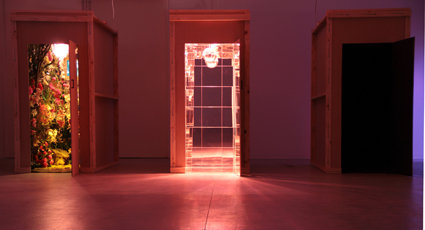
Ray Harris, I’ve been here before series
photo Ray Harris
Ray Harris, I’ve been here before series
In the I’ve been here before series, the five rooms represent a cycle of life. They are: a bed with teddy bears, curtained in pink to mimic the vagina and suggest the womb; a garden of plastic flowers and intense artificial perfume, possibly a Garden of Eden; a darkened interior with a dimly illuminated hole in the floor that could be a passage to the underworld; a room whose interior is entirely of mirrors, including a mirror ball; and lastly a room of plastic bags of water and tubing suggesting drip-fed life, as if we’re inside a dying body. The physical body is central to this work, and each room locates the viewer in claustrophobic, contextualising space to offer an oblique window onto the self.
In her artist’s statement, Harris writes, “Like the small scratch on a sapling’s bark that grows to a big cut, these are the narcissistic wounds and scars, the yearnings and fantasies, the denials and re-creations and the inextricable knots that keep us tied to the ones we never had.” In exploring narcissism Harris uses herself as the exemplar in the videos and the viewer as exemplar or avatar in the five rooms. In the room of flowers, you see yourself on CCTV and in the mirror room you have a panoptical, infinitely multiplying view of yourself. I found myself watching dispassionately as if witnessing narcissism rather than experiencing it. But this is not a failure of the work, which succeeds in triggering understanding. It’s the intellectualisation of narcissism, a bleak commentary on what we see as significant in our lives and how delusional we can be. The title Hold me Close and Let me Go suggests contradictory desires, and the work is a darkly humorous exploration of sexual dynamics.
Harris’ work frequently involves videos in which she acts out a symbolic ritual or play flavoured with the theme of the abject figure in the world. Her 2010 video Glittervomit shows her in close-up regurgitating a mouthful of glitter at the camera, as if sickened by the superficiality being pushed down her throat. She weeps in Cry Me a Ravine (2010) and she is the deceased in a funeral parlour in I Wish I was Dead (2010). Critical self-examination as distinct from narcissism is a strategy essential to our functioning in the world.
Christine Collins, I may have to see YOU again, Charlie; Ray Harris, Hold me Close and Let me Go, Australian Experimental Art Foundation, AEAF, September 30 – October 29 2011; http://aeaf.org.au/
Collins recorded an interview for the CACSA Contemporary 2010: The New New exhibition which can be seen here
This article first appeared in e-dition Nov 8
RealTime issue #106 Dec-Jan 2011 pg. web
© Chris Reid; for permission to reproduce apply to realtime@realtimearts.net





































